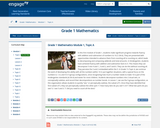
Provided in the content is only one doubles sheet. To play with more than one student at a time, multiple copies will have to be made with different patterns. Some students will still need to have concrete manipulatives available to them so that the can create the double, or you might ask the students to make a picture to should how they doubled (did they make pairs, did they count out the given value and then make a copy).For each player distribute:1 card.20 counters to mark spaces on the cardCaller should have:1 10-faced die1 spinner split into sixths each sixth should have a letter from the word D-O-U-B-L-E in it.Directions:Have the caller read out a letter-number combination. The caller should roll the die and spinner the spinner to identify the letter-number combination.Place a chip on your scorecard if you have that letter and number. Students will find the letter given by the and will have to double the value from the die since every number on a Doubles card should only have numbers that can be created by doubling. Continue playing until someone gets 5 chips in a row on their scorecard. Othe variations include Blackout (fill the whole card), X Marks the Spot (two diagonal lines that intersect in the middle and include the four corners), Perimeter-or Square (fill all of the spaces on the outside edge), etcShout "DOUBLE” if you get 5 squares in a row (or you have completed the variation).Repeat
- Subject:
- Numbers and Operations
- Material Type:
- Lesson Plan
- Author:
- Samuel Shackleford
- Date Added:
- 05/29/2018
